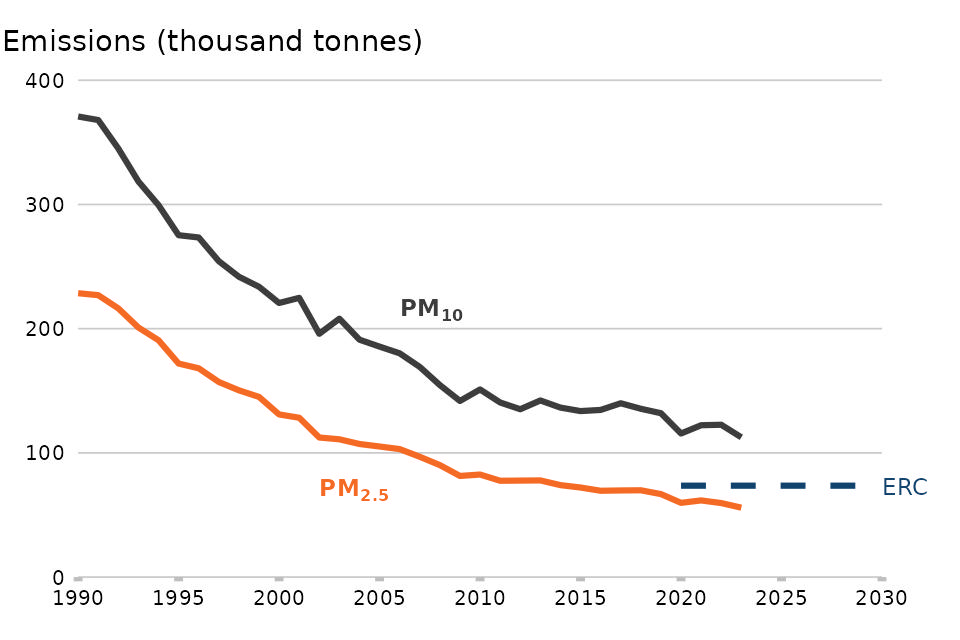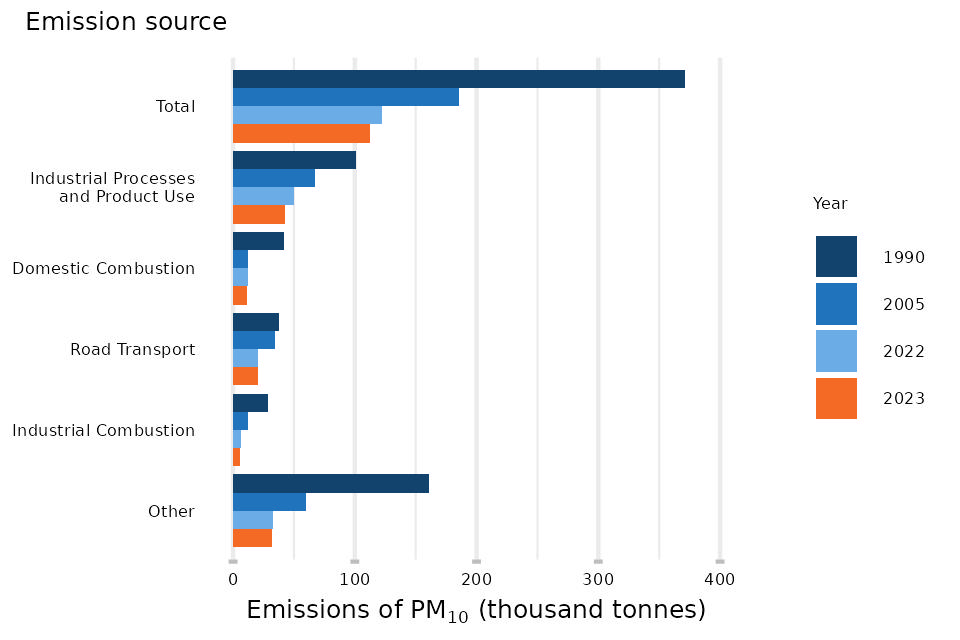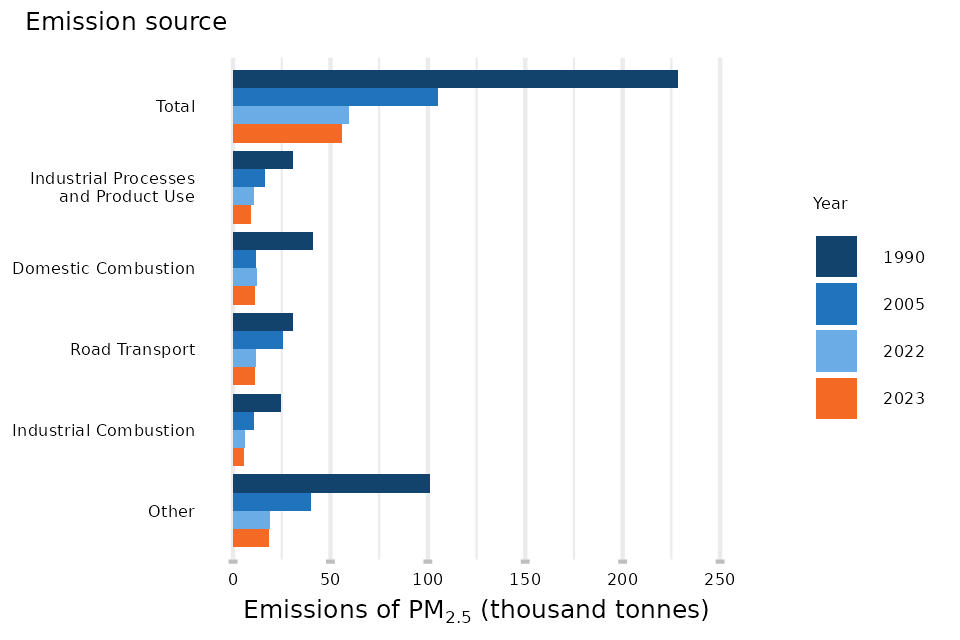Emissions of air pollutants in the UK – Particulate matter (PM10 and PM2.5)
Updated 13 March 2025
1. What is particulate matter, and why are emissions of it estimated?
Particulate Matter (PM) is everything in the air that is not a gas and as such it is made up from a huge variety of chemical compounds and materials, some of which are toxic. Due to the small size of many of the particles that form PM, some of these toxic compounds may enter the bloodstream and be transported around the body, entering the heart, brain and other organs. Therefore, exposure to PM can result in serious health effects and is associated with respiratory conditions (such as asthma), cardiovascular disease (CVD), and lung cancer, and there is emerging evidence for associations with dementia, low birth weight and Type 2 diabetes. People such as the young, elderly and those with respiratory problems are most vulnerable to these effects.
When reporting UK emissions, PM is classified according to particle size: PM10 refers to particles smaller than 10 micrometres in diameter, while PM2.5 refers to finer particles smaller than 2.5 micrometres. By definition, PM10 emission measurements or estimates include PM2.5, meaning that the total mass of PM10 emissions is always greater than that of PM2.5. To isolate the coarse fraction of particulate matter (PM coarse), the mass of PM2.5 is subtracted from PM10 (PM coarse = PM10 - PM2.5). This classification approach is based on scientific consensus and longstanding evidence regarding how particles of different sizes penetrate the respiratory system and are absorbed by the lungs.
Different emission sources produce different proportions of coarse and fine particulate matter. For example, construction and demolition emit a higher proportion of coarse particles (PM10 - PM2.5), while in industrial and domestic combustion the majority of PM emissions are fine particles (PM2.5).
“Primary” PM is emitted directly as particles (for example, soot or dust) and “secondary” PM is formed in the atmosphere through changes in pollutants and reactions between them. For example, ammonia reacts with nitrogen oxides (NOx) resulting in ammonium nitrate particulates. Both PM and the precursor pollutants that form it can travel large distances through the air. Around half of the concentrations of PM that people in the UK are exposed to come from either naturally occurring sources, such as pollen and sea spray, or are transported to the UK from international shipping and other countries. The remaining PM in UK air results from human activities in the UK, such as wood burning, various industrial processes and emissions from vehicles (mainly from tyre and brake wear).
As human activity in the UK contributes such a high proportion of the concentrations, it is in the interest of the UK to identify and reduce all these emissions where possible. Therefore, the National Atmospheric Emissions Inventory, and the statistical tables published as part of this release, focus on emissions of “primary” PM from human activities in the UK, but there are a few exceptions included as memo items, such as international shipping and aviation. The information presented in this document only covers “primary” PM emissions from human activities within the UK. However, the precursor pollutants ammonia, NMVOCs and NOx are also covered in their own sections.
The Convention on Long Range Transboundary Air Pollution’s amended Gothenburg Protocol (CLRTAP) and the National Emission Ceilings Regulations (2018) (NECR) require the UK to reduce emissions of PM2.5 by 30 per cent compared to emissions in 2005 by 2020 and to stay below this level in each subsequent year. The NECR also requires the UK to reduce emissions by 46 per cent compared to emissions in 2005 by 2030. The UK needs to estimate emission levels to assess and report on progress made towards these commitments. There are no commitments relating to emissions of PM10 specifically, but due to sharing sources with PM2.5 any reductions in PM2.5 will also impact on PM10.
2. Trends in total annual emissions of PM10 and PM2.5 in the UK, 1990 to 2023
Figure 3: Annual emissions of PM10 and PM2.5 in the UK: 1990 – 2023

Note:
- ‘ERC’ refers to the UK 2020-2029 emission reduction commitment, as set out in the National Emission Ceilings Regulations (2018) and the ‘2020 and beyond’ emission reduction commitment, as set out in the Convention on Long Range Transboundary Air Pollution. These commitments apply to PM2.5 only.
View the data for this chart (years available: 1970-2023)
Download the data for this chart in CSV format (years available: 1970-2023)
Annual emissions of PM10 have decreased by 70 per cent since 1990, to 113 thousand tonnes in 2023. They have decreased by 8 per cent between 2022 and 2023.
Annual emissions of PM2.5 have decreased by 76 per cent since 1990, to 56 thousand tonnes in 2023. They have decreased by 6 per cent between 2022 and 2023.
In the UK PM2.5 emissions decreased by 47 per cent between 2005 and 2023. Therefore, in 2023, the UK met the 30 per cent emission reduction commitment required between 2020 to 2029 as set out in the NECR.
Emissions of particulate matter generally decreased between 1990 and the early 2000’s. There are many reasons for this long-term decrease, which covers most emissions sources, but the reduction in the burning of coal and improved emission standards for transport and industrial processes are major drivers. Since the late 2000s annual emissions of PM have generally continued to fall, but the rate of change has reduced. Compared to earlier decades, emission levels have been relatively steady with small annual fluctuations. In these more recent years, considerable decreases in emissions from some sources (e.g. from road transport and energy industries) have been partly offset by increases in emissions from other activities, such as wood burning in domestic settings and the burning of biomass-based fuels in industry. In 2020 PM emissions fell at a greater rate than in recent years due to reduced activity across a number of emissions sources . Whilst there was a small increase in 2021, the overall downward trend has continued. In 2023 PM2.5 and PM10 emissions were at the lowest level since emission estimates have been calculated. Emissions of particulate matter fell from 2022 to 2023, in part due to a fall in emissions from construction and quarrying activity, as well as reduced emissions from product use.
3. Major emission sources for PM10 and PM2.5 in the UK
Figure 4: Annual emissions of PM10 in the UK by major emission source: 1990, 2005, 2022 and 2023

Notes:
-
‘Industrial processes and product use’ refers to specific industrial production processes, including some where fuel combustion is a necessary part of the process, such as the production of steel. This also includes the use of manufactured products, both industrial (such as the use of solvents, adhesives and lubricants) and non-industrial (such as cigarette smoking).
-
‘Industrial combustion’ refers to the burning of fuels on manufacturing and construction sites, to generate energy for industrial use, for example to drive mobile machinery or to create heat or electricity for industrial processes. This does not include emissions from public electricity and heat production, from the production of fuels, or from fuel combustion in the public sector, the commercial sector, or the agricultural, forestry and fishing sectors.
Download the data for this chart in CSV format
Figure 5: Annual emissions of PM2.5 in the UK by major emission source: 1990, 2005, 2022 and 2023

Notes:
-
‘Industrial processes and product use’ refers to specific industrial production processes, including some where fuel combustion is a necessary part of the process, such as the production of steel. This also includes the use of manufactured products, both industrial (such as the use of solvents, adhesives and lubricants) and non-industrial (such as cigarette smoking).
-
‘Industrial combustion’ refers to the burning of fuels on manufacturing and construction sites, to generate energy for industrial use, for example to drive mobile machinery or to create heat or electricity for industrial processes. This does not include emissions from public electricity and heat production, from the production of fuels, or from fuel combustion in the public sector, the commercial sector, or from the agricultural, forestry and fishing sectors.
Download the data for this chart in CSV format
Industrial combustion is a major source of PM emissions, contributing 10 per cent of PM2.5 emissions and 5 per cent of PM10 emissions in 2023. PM emissions from industrial combustion have reduced in the long term as the use of coal as a fuel has fallen. However, emissions from this source have been relatively stable since 2008, with only a small drop overall, as reductions in emissions from the industrial combustion of fossil fuels have been partly offset by an increase in the industrial combustion of biomass-based fuels. Industrial combustion of biomass-based fuels contributed less than 1 per cent of total PM2.5 emissions in the years prior to 2009 but has since risen to represent 5 per cent of total PM2.5 emissions in 2023.
Emissions from industrial processes and product use contributed 16 per cent of total PM2.5 emissions and 38 per cent of total PM10 emissions in 2023. Emissions from this source have decreased in the longer term, in part due to declining emissions from the metal production industries, particularly in the iron and steel sector. Since 1990, construction has been the most emitting sector within this source, representing 22 percent of total PM10 emissions and 4 per cent of total PM2.5 emissions in 2023; within which, most emissions come from the construction of roads and non-residential buildings. Emissions of both PM10 and PM2.5 from construction activity have declined by 49 per cent since 1990. Quarrying activity contributed 7 per cent of total PM10 and 1 per cent of total PM2.5 emissions in 2023, although emissions have declined by 55 per cent since 1990 for both PM10 and PM2.5. Emissions from the use of solvents and other products have also fallen by 74 per cent for PM25 and 72 per cent for PM10 between 1990 and 2023.
Domestic combustion refers to households burning a variety of fuels including wood, solid smokeless fuels, coal and fuels derived from waste such as coffee logs. This was a major source of PM emissions in 2023, contributing 20 per cent of total PM2.5 emissions and 10 per cent of total PM10 emissions. Emissions of PM2.5 and PM10 from domestic combustion had fallen by 7 per cent from 2022 to 2023. Looking at the longer-term trend, from 1990, emissions of both PM2.5 and PM10 from domestic combustion declined by 76 per cent to reach the lowest level in the time series in 2009, largely due to a reduction in the burning of coal. From 2009 through to 2020, emissions of both PM2.5 and PM10 from domestic combustion rose by 36 per cent, largely due to a rise in emissions from the burning of wood. From 2020 through to 2023, PM10 and PM2.5 emissions from the domestic combustion of all types of fuel fell by 17 per cent. In recent years, most emissions from domestic combustion came from households burning wood indoors, which contributed 11 per cent of total PM2.5 emissions and 6 per cent of total PM10 emissions in 2023.
Road transport continues to be a major source of PM emissions, contributing 21 per cent of total PM2.5 emissions and 18 per cent of total PM10 emissions in 2023. Emissions can originate from fuel burned in vehicle engines that are released through the exhaust and so are described as exhaust emissions. Exhaust emissions have decreased markedly from 1996 to 2023 due to stricter emissions standards (decreased by 93 per cent for both PM2.5 and PM10). The other type of vehicle emissions do not originate from fuel burning but rather from other aspects of the vehicle’s operation; these are known as non-exhaust emissions. This includes very small particles released into the air as the brake pads and discs wear down during braking, particles shed from tyres, and dust and debris generated by the gradual erosion of road surfaces. Non-exhaust emissions have increased by 18 per cent for PM2.5 and increased by 17 per cent for PM10 between 1996 and 2023, in part due to the rise in the distance travelled by vehicles each year and the trend towards heavier vehicles. This means that most PM emissions from road transport derive from non-exhaust sources, which alone contributed 17 per cent of total PM2.5 emissions and 16 per cent of total PM10 emissions in 2023.
Detailed data on the amount of pollutants and trends in emissions from specific sources are available for the period 1990 to 2023 through the statistical tables that accompany this release.
Sections in this release
Emissions of non-methane volatile organic compounds
Methods and quality processes for UK air pollutant emissions statistics (PDF)
